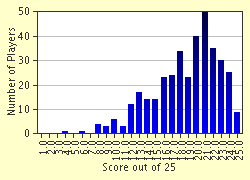Quiz Answer Key and Fun Facts
1. Staccato means . . . ?
2. The tempo is . . . ?
3. The fine is . . . ?
4. Piano is louder than forte.
5. D.C. stands for . . . ?
6. Adagio means slow.
7. Which of the following would make no sense written at the beginning of the music?
8. An enharmonic is . . . ?
9. In a time signature(eg 4/4), what does the top number stand for?
10. Tenuto is the opposite of what other musical term?
11. A question always on the final is marches by Sousa. So which one didn't he write?
12. The sign which looks like a percent sign (%) means what when written in a measure?
13. What is the order of flats in a key signature?
14. In a concert Eb key signature, how many flats are there?
15. What musical word means "play in a similar manner"?
16. What is a scale?
17. Ad Libitum (ad lib) is usually played in what sort of music?
18. If something is to be played "the same", how is it played?
19. When tacet is written in music, what does it mean?
20. 8va means what?
21. What is the correct order of sharps in a key signature?
22. Embouchure is . . . ?
23. There is a term known as a double sharp.
24. A tempo means what?
25. A fife is related to a flute.
Source: Author
TheMaskedCokie
This quiz was reviewed by FunTrivia editor
bullymom before going online.
Any errors found in FunTrivia content are routinely corrected through our feedback system.


